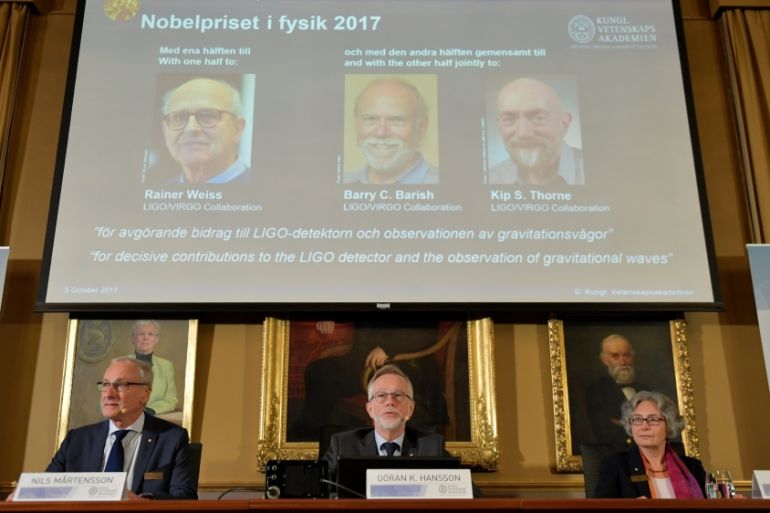Weiss, Barish and Thorne win Nobel Physics Prize
Winners’ project observed waves of energy created by violent processes such as colliding black holes for the first time.

US astrophysicists Rainer Weiss, Barry Barish and Kip Thorne have been awarded the Nobel Prize for physics for their pioneering role in the detection of gravitational waves.
Predicted by Albert Einstein more than 100 years ago as part of his theory of general relativity, but only detected in 2015, gravitational waves are “ripples” in the fabric of space-time caused by violent processes, such as colliding black holes or the collapse of stellar cores.
Keep reading
list of 4 itemsHong Kong’s first monkey virus case – what do we know about the B virus?
Why will low birthrate in Europe trigger ‘Staggering social change’?
The Max Planck Society must end its unconditional support for Israel
Scientists say the detection of gravitational waves will open a new window on the universe.
READ MORE: Einstein’s gravitational waves detected by scientists
“This is something completely new and different, opening up unseen worlds,” the Royal Swedish Academy of Sciences said in a statement announcing the winners of the nine million Swedish krona ($1.1 million) award.
“A wealth of discoveries awaits those who succeed in capturing the waves and interpreting their message.”
Weiss won half the prize, with Barish and Thorne sharing the other half.
![Weiss uses a visual aide to discuss the detection of gravitational waves, [File: Gary Cameron/Reuters]](/wp-content/uploads/2017/10/b330fa110847433185c8be89eb1b962b_18.jpeg)
First-ever direct observation
The three scientists cocreated the Laser Interferometer Gravitational-wave Observatory (LIGO) at the prestigious California Institute of Technology, which has taken home 18 Nobels since the prizes were first awarded in 1901.
The first-ever direct observation of gravitational waves was made in September 2015 at LIGO, the result of an event some 1.3 billion light years away.
Since then, the enigmatic ripples have been detected three more times: twice more by LIGO and once by the Virgo detector located at the European Gravitational Observatory (EGO) in Cascina, Italy.
“Gravitational waves spread at the speed of light, filling the Universe, as Albert Einstein described in his general theory of relativity. They are always created when a mass accelerates, like when an ice skater pirouettes or a pair of black holes rotate around each other,” the Nobel jury said.
“Einstein was convinced it would never be possible to measure them. The LIGO project’s achievement was using a pair of gigantic laser interferometers to measure a change thousands of times smaller than an atomic nucleus, as the gravitational wave passed the Earth.”
Physics is the second of this year’s crop of Nobel Prizes and comes after Americans Jeffrey Hall, Michael Rosbash and Michael Young were awarded the Nobel Prize for physiology or medicine on Monday.
The prizes for achievements in science, literature and peace were first awarded in 1901 in accordance with the will of Swedish business tycoon Alfred Nobel, who bequeathed much of the fortune he generated from his discovery of dynamite.
Among the science prizes, physics has often taken centre stage with laureates including scientific superstars such as Einstein, Niels Bohr and Marie Curie, one of only two women to win a Nobel Prize for physics.